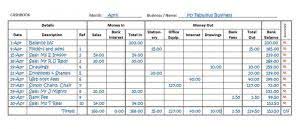
Accounts payable is a liability account, keeping track of bills I still have to pay in future. In this image, you can see a T-account which shows my bank account for the first week of March. Every day, I receive cash from my coffee sales shown in the debit column on the left. In the right column, the credits represent cash being spent either on inventory or operating costs. Due to its simplistic nature, T-accounts are also used as a learning tool to practice transactions and double-entry accounting. They can be found drawn on a scrap piece of paper to templates made in accounting software.
What is the General Ledger

Liabilities, Owner’s Equity and Revenue go on the right to increase them. Your debits go on the left, credits on the right side and the line down the middle separates them. T Accounts allows businesses that use double entry to distinguish easily between those debits and credits. By breaking transactions down into a simple, digestible form, you can visualise which accounts are being debited and which are being credited. The left side of the T-account is for debits, and the right side is for credits.
Example of a Transaction

Increases to the Cash account go on the left side of the T; decreases go on the right. So you need three T accounts, Cash, Vehicles, and Truck Loan. On a blank piece of paper, draw your three T accounts, making them large enough you can write numbers on either side of the T. To explain T accounts, let’s first take a look at a simple example of how they work. Now that we established a T account is a visual representation of an account, most people wonder if they can do this for any account.
T-Accounts and Ledgers

A positive result means a debit balance; a negative result means a credit balance. If you’re diving into journal entries and double-entry bookkeeping, understanding T-accounts is a must. Let’s break down the basics and components of T-accounts in a way that makes sense. It can be used to balance books by adding all transactions in a set of accounts so the total debits equal the total credits for each account. A T-account is used in bookkeeping, which involves keeping track of the financial transactions that occur within a business.
- In this image, you can see a T-account which shows my bank account for the first week of March.
- The two totals for each must balance, otherwise there is an error in the recording.
- If you’ve been studying accounting for even a short amount of time then you’ve probably heard of T-accounts and ledgers.
- For instance, the asset account records all of the changes in assets over time like asset purchases and sales.
- Now these ledgers can be used to create an unadjusted trial balance in the next step of the accounting cycle.
- In our next lesson we’re going to continue working with T-accounts and focus on a very important aspect of them – learning how to balance T-accounts.
Luckily there is an easy way to keep it straight at an account level. We will look at what T accounts are and how to use them so you can grasp accounting easier. As I stated before, some accounts will https://www.bookstime.com/articles/what-are-t-accounts have multiple transactions, so it’s important to have a place number each transaction amount in the debit and credit columns. You can see that in the posting examples in the next section.
- For more insights, visit our accounting general journal entries.
- T Accounts allows businesses that use double entry to distinguish easily between those debits and credits.
- When a company issues shares worth $100,000, the transaction impacts both the asset and equity accounts.
- Finally, we credit supplies for $25 and debit a cost of sales T account for $25.
- A positive result means a debit balance; a negative result means a credit balance.
- This system, which records every transaction in at least two accounts, ensures that your books are always balanced.
At the top of the T-account, just above the horizontal line, the title of the account is clearly displayed, establishing its purpose and facilitating easy identification. The following T-account examples provide an outline of the most common T-accounts. It is impossible recording transactions to provide a complete set of examples that address every variation in every situation since there are hundreds of such T-accounts. The visual presentation of journal entries, which are recorded in the general ledger account, is known as the T-Account. It is called the T-account because bookkeeping entries are shown in a way that resembles the shape of the alphabet T. It depicts credits graphically on the right side and debits on the left side.
Understanding T-Account
- Each T represents a separate account in your books or accounting software.
- With the outstanding bill paid, accounts payable account is debited by £700, reducing its value and showing that I no longer owe this amount.
- The typical accounts include accounts of assets, liabilities, shareholders’ equity, revenues, and expenses, etc.
- Once journal entries are made in the general journal or subsidiary journals, they must be posted and transferred to the T-accounts or ledger accounts.
- The articles and research support materials available on this site are educational and are not intended to be investment or tax advice.
It is one of the best ways to keep debits and credits straight, visually. Next we are going to build off what we have just learned and look at the normal balances of accounts in accounting. A double entry system is considered complex and is employed by accountants or CPAs (Certified Public Accountants). The information they enter needs to be recorded in an easy to understand way. This is why a T account structure is used, to clearly mark the separation between “debits” and “credits”. They make it easy to record transactions and understand the basics of accounting.

Apart from these reasons, the T-account is also foolproof, which makes them the first choice for accountants. After a few days of receiving the invoice for the rent, i.e., on April 7th, 2019, Mr. X makes the same payment. A financial professional will offer guidance based on the information provided and offer a no-obligation call to better understand your situation. For information pertaining to the registration status of 11 Financial, please contact the state securities regulators for those states in which 11 Financial maintains a registration filing. A business owner can quickly look over T-accounts (such as the one in our example) in order to extract information. The above transaction would not only affect the Bank T account but also affect the contra account or second account, Capital.
The credit was to loan, so this is used to describe what has happened to our bank account above. The next transaction relating to the bank account was on the 7th of April. By account, we mean a summary record of all transactions relating to a particular item in a business. A t-account is a visual representation of a financial account for a financial accounting period. Okay, for the first transaction, there will need to be a credit to the Cash T account for $300 and a debit to an equipment T account Certified Bookkeeper for $300.
Leave a Reply